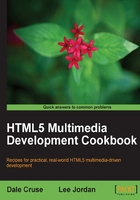
Structuring a blog article
"The
<article>element represents a self-contained composition in a document, page, application, or site and that is, in principle, independently distributable or reusable, e.g. in syndication. This could be a forum post, a magazine or newspaper article, a blog entry, a user-submitted comment, an interactive widget or gadget, or any other independent item of content." - WHATWG's HTML5 Draft Standard - http://whatwg.org/html5
Getting ready
Blog entries are perfect candidates for the new <article> element, which is designed for syndicated content.
For this recipe, let's start by identifying the major elements of a blog <article>: There's usually a headline in the form of a heading tag, the blog entry itself consisting of several paragraphs and perhaps one or more images, and some information that usually includes the author's name and other related metadata. Notice this is all self-contained related content.
How to do it...
We're going to continue using the new HTML5 <header> and <footer> elements. The headline, entry and meta-information should be wrapped in their own unique tags, like <h2>, multiple <p>s and the new <footer>.
Let's start with a foundation very similar to what we used in the last chapter, and add our new <article> element twice:
<!DOCTYPE html> <html lang="en"> <head> <meta charset="UTF-8"> <title>Blog Title</title> <!--[if lt IE 9]><script src="http://html5shiv.googlecode.com/svn/trunk/html5.js"> </script>[endif]--> <!--[if lt IE 9]><script src="http://html5shiv.googlecode.com/svn/trunk/html5.js"> </script>[endif]--> <meta name="viewport" content="width=device-width, initial-scale=1.0"> </head> <body> <article> <header> <h2>Headline</h2> </header> <p>First paragraph</p> <p>Second paragraph</p> <footer>Meta information.</footer> </article> <article> <header> <h2>Headline</h2> </header> <p>First paragraph</p> <p>Second paragraph</p> <footer>Meta information.</footer> </article> </body> </html>
Put your code on a diet?
Ready for a shocker? Want to have your mind blown? The <html> and <head> and <body> tags (as well as their closing tags) are now optional in the HTML5 specification. Sure, you could leave them in there, and your pages will validate just fine, but why should we? If remove them from the previous code, we are left with the spartan:
<!DOCTYPE html> <meta charset="UTF-8"> <title>Blog Title</title> <!--[if lt IE 9]><script src="http://html5shiv.googlecode.com/svn/trunk/html5.js"> </script>[endif]--> <meta name="viewport" content="width=device-width, initial-scale=1.0"> <article> <header> <h2>Headline</h2> </header> <p>First paragraph</p> <p>Second paragraph</p> <footer>Meta information.</footer> </article> <article> <header> <h2>Headline</h2> </header> <p>First paragraph</p> <p>Second paragraph</p> <footer>Meta information.</footer> </article>
Don't believe me? Run that code through the World Wide Web Consortium's validator at: http://validator.w3.org, and you'll see it displays correctly in the browser.
Well, not so fast buster. The problem is that removing those elements breaks our code for screen readers. Uh oh. Strike one. Also, removing the <body> tag breaks our new HTML5-enabling JavaScript for Internet Explorer. Strike two. And guess what? You can see it coming, can't you? Yes, removing the <html> tag removes the language of the page. There it is: Strike three.
So let's add those elements back in, shall we?
<!DOCTYPE html> <html lang="en"> <head> <meta charset="UTF-8"> <title>Blog Title</title> <!--[if lt IE 9]><script src="http://html5shiv.googlecode.com/svn/trunk/html5.js"> </script>[endif]--> <meta name="viewport" content="width=device-width, initial-scale=1.0"> </head> <body> <article> <header> <h2>Headline</h2> </header> <p>First paragraph</p> <p>Second paragraph</p> <footer>Meta information.</footer> </article> <article> <header> <h2>Headline</h2> </header> <p>First paragraph</p> <p>Second paragraph</p> <footer>Meta information.</footer> </article> </body> </html>
There, that's better.
How it works...
Remember, the new <article> element is a collection of related information intended for syndication via RSS or another means.
There's more...
Richer, more meaningful semantics is perhaps the most significant goal for HTML5. It's better for machines, better for authors, and most importantly, better for our audiences.
Validation as an aid, not a crutch
As we saw previously, removing the <html> and <head> and <body> tags render a still valid page. So that begs the question of how valid validators are. Unlike the XML world, HTML5 can use incorrect syntax and still render just fine.
The author makes every effort to validate his code whenever possible. It's not necessary to be slavish to the validator, but it's always a good quality control check. And the closer you get to valid code, the better chance browsers will display your work in as consistent a manner as possible.
Where to find validators
You can make good use of code validators at:
See also
Kristina Halvorson's book "Content Strategy For The Web" (http://contentstrategy.com) was an instant classic from the time of its release. In it, Halvorson, CEO of Minneapolis-based company Brain Traffic, clearly defines the process of how to create and deliver useful and usable content for online audiences.
